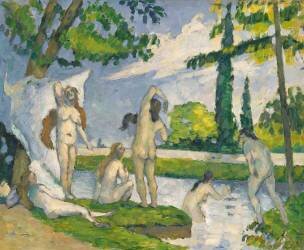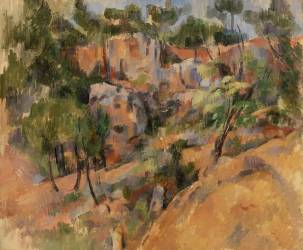Artwork of Paul Cézanne canvas prints & artprints
Considered one of the precursors of Impressionism and modern painting, Paul Cézanne's interest in theories of color perception and perspective, as well as his influence on the development of the Parisian art scene, left their mark on 19th-century art history.
Discover the most beautiful paintings available in the catalog of one of the greatest French painters, herald of post-Impressionism and Cubism, with "Les joueurs de cartes", an oil on canvas from his series of 5 paintings from the end of his Impressionist period, "Les Grandes Baigneuses", an unfinished painting nevertheless considered one of the artist's masterpieces, "Madame Cézanne en bleu", the best-known portrait of his partner Hortense, and "Pommes et cookies", a still life featuring apples, his favorite fruit since the beginning of his friendship with Émile Zola.
Treat yourself to one of the finest reproductions of Paul Cézanne available in the catalog, and discover his biography.
Paul Cézanne biography
Paul Cézanne's youth in Provence.
The son of a hatter father and a working-class mother, Paul Cézanne was born in Aix-en-Provence in 1839. Living with his parents on what is today known as the Cours Mirabeau, the Cézanne family quickly joined the petty bourgeoisie of the second half of the 19th century, his father opening the "Cézanne et Cabassol" bank in Aix-en-Provence. During this period, Cézanne attended the Collège Bourbon, where he met a number of future Parisian notables, the most famous of whom was Émile Zola, with whom he became close friends. It was at school that, protecting Zola in the playground, Cézanne in return received a basket of apples, a fruit that would remain a recurring subject in his still lifes throughout the artist's career. Parallel to his classical training, Cézanne studied academic painting, painting more and more until he won several prizes in his home town. He began studying law, but soon abandoned his studies, and finally, with his father's support, moved to Paris in 1861.
Between Paris and Aix-en-Provence, Paul Cézanne got off to a difficult start.
Joining his friend Émile Zola, Paul Cézanne tried his luck at the École des Beaux Arts when he arrived in Parisian art circles. The Académie des Beaux Arts rejected his application, deeming the use of vivid hues in the young realist painter's compositions too far removed from the academicism advocated by the institution. Disappointed, Cézanne returned to Aix-en-Provence to work in his father's bank, before returning to Paris a few months later to join the Charles Suisse Academy and become a copyist at the Louvre, where he drew inspiration from Romantic painters such as Delacroix. It was also during this period that Paul Cézanne met a number of young painters with whom he would remain in contact throughout his life, including Camille Pissarro, Pierre Auguste Renoir, Claude Monet and Alfred Sisley. Rejected at the official Salon, he nevertheless met Manet and Father Tanguy, a famous art and color dealer, who enabled him to exhibit as far away as Madrid.
Between bursts of motivation at the success of his friends, and moments of doubt at his failures, Cézanne navigated between Paris and Aix-en-Provence, where he went to recharge his batteries. In 1869, he met his future wife, Hortense Fiquet, of whom he painted many portraits. However, Cézanne preferred to keep this relationship secret from his family, even concealing the existence of a son, born in 1872. When the Franco-Prussian war broke out in 1870, he left Hortense at his home in l'Estaque, Provence, and moved to the bastide of Jas de Bouffan, where he stayed until 1871, before returning to Paris with his pregnant partner.
Cézanne, the Impressionist painter.
In 1872, Paul Cézanne moved into a house in Auvers sur Oise, near the famous Docteur Gachet, later immortalized by Vincent Van Gogh. In his studio, where he regularly welcomed future Impressionist painters Pissarro, Degas, Monet and Renoir, he created the Société Anonyme Coopérative des Artistes Peintres, bringing together all the famous painters of what was to become known as the Impressionist movement. Inspired by the Salon des Refusés of 1863, but aiming to be more open by accepting classic, prize-winning works alongside Impressionist paintings that sometimes caused a scandal, Cézanne was a trailblazer, and in 1874 organized the first exhibition of Impressionist painters on the Boulevard des Capucines, in photographer Nadar's studio, where he presented three canvases: "La Maison du pendu", "La Moderne Olympia" and "Paysage d'Auvers". Cézanne and all the most innovative painters of the period were to contribute to the development of one of the most important pictorial movements of the second half of the 19th century.
Although the Impressionists' various exhibitions were a success with the public, Paul Cézanne saw money problems ahead. The artist continued to paint between the Paris region and l'Estaque, where he went more and more frequently. In 1878, through a letter, his father discovered the existence of Hortense and her son, who was ill at the time. In response, through the intermediary of Docteur Gachet, Cézanne's father increased his son's pension. Back in Paris in 1879, Paul Cézanne tried his luck at the official salons of 1879, 1880 and 1881, but failed again and again. Settling in Pontoise, he studied the color perception theories of scientists such as Chevreul and Rood, and began to incorporate aerial perspective into his work, marking the depth of space by gradually softening contours and shading colors. At this point, chiaroscuro became of paramount importance in the French painter's work.
Provence and Paul Cézanne's travels.
In 1881, Paul Cézanne had his father build him a studio in Jas de Bouffan. In the summer of 1882, he moved permanently to Provence, where he drew inspiration from the surrounding landscapes, repeatedly painting the countryside around l'Estaque and Jas de Bouffan, as well as Montagne Sainte-Victoire, a landscape he would later depict in a series of paintings. In 1886, he married his long-time companion Hortense, who officially became his wife after 17 years together. In the same year, his father died, bequeathing him a large part of his fortune, sheltering the painter and his family for the rest of his life. In 1888, after several years spent almost exclusively in Provence, Cézanne returned to Paris, no doubt to avoid being locked into his own style of painting. With renewed inspiration, he took part in the 1889 Universal Exhibition, and exhibited at the Salon des XX in Brussels.
In 1890, after a trip to the Doubs region for administrative reasons, he continued in Switzerland, where, although he usually worked in oil on canvas, he also produced numerous watercolors. At the same time, the painter's name became increasingly famous among art critics, and his paintings were exported beyond France's borders. In 1894, Cézanne stayed with Monet in Barbizon, then in Vichy, where he treated his diabetes. As his reputation grew, art dealer Ambroise Vollard even devoted a retrospective to him, with 150 works by the painter on display. The last works of his Impressionist period appeared, such as "Les joueurs de cartes" ("The Card Players"), a portrait presented almost as a still life, in a series of 5 canvases that heralded Cézanne's future style, closer to a contemporary classicism.
















































































































































